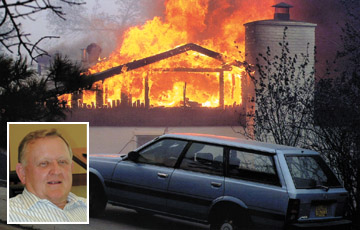
August/September 2000 (Volume 9, Number 8)
Viewpoint: A Personal Account of the Los Alamos Cerro Grande Fire
 A home in Los Alamos, NM burns. Inset photo of Benjamin Gibson. (Jim Thompson/Albuquerque Journal; Inset photo by Ken Cole/APS) |
The fire blew out of control and was declared a wildfire early on May 5th. However, the real disaster occurred sometime on May 6th, when a "back burn," set to contain the original fire, reportedly blew out of control in the high winds that often blow through the mountains at that time of the year. By May 7th, the fire was burning furiously to the west of Los Alamos National Laboratory, raging through the trees within a few hundred yards of Camp May Road, which leads up the edge of Los Alamos Canyon to the ski area, and along East Jemez Road, which borders the Lab to the west. An evacuation of the Western Area of Los Alamos was announced that evening, terminating a meeting which I was attending in the evacuated area. As I drove home, the flames were 25 feet high in the trees south of Camp May Road, and the slurry bombers were hard at work. The winds subsided overnight, so that the fire was contained south of the canyon, and the situation was stable until the high winds returned on Wednesday.
Los Alamos was evacuated on Wednesday afternoon, May 10th, when the fire jumped the fireline at Camp May Road into Los Alamos Canyon. The canyon separates the town site and the Laboratory, although the fire was much farther west than the bridge over the canyon, and there was no danger to evacuees crossing the bridge. Baranca Mesa and North Mesa communities were evacuated to the north through Rendia Canyon across pueblo property. Horses and livestock on North Mesa were part of the evacuation. It was later reported that the evacuation of Los Alamos had taken only 4-1/2 hours instead of the estimated 11 hours prior to the call; moreover, the TV reports marveled at the silence in which it was accomplished - no automobile horns honked. As a result of the Los Alamos evacuation, our community of White Rock grew in population from its normal 7,000 residents to a population of 14,000, as many from the town site sought shelter there. The fire had burned north through Los Alamos, but then the swirling winds blew the rear of the fire southeast across Lab property in the direction of White Rock and Santa Fe. About 1:00 a.m. the call came to evacuate White Rock. We spent three hours packing my car with pictures, papers etc. before beginning the drive to Albuquerque. From there we were TV spectators as the local channels provided 24-hour coverage of Los Alamos burning.
A firestorm (flames 100 feet high) roared through the western edge of the Los Alamos town site the evening of May 10th, driven by wind gusts of up to 50 mph. The forest (mostly ponderosa pine) exploded in flame, spreading firebrands up to 1/4 mile in advance of the wind-driven fire front. More than 202 town site structures were burned to the ground in the intense heat, and 405 families lost their homes. The burned structures lay primarily along the streets which border the forest - in the Western Area and the Northern Community, to the west of Diamond Drive (which goes over the bridge).
Some homes were saved by a handful of people who defied the evacuation order and remained behind to battle the fire with garden hoses, spraying the falling embers and burning pine needles with water. The Laboratory lost 39 temporary structures - people's offices and labs and storage. The fire burned some 30% of the 43 square miles of Laboratory property. At the plutonium site, which was sandwiched between fires on the north and south, the wind in the center of the firestorm was measured to be in excess of 85 mph. Aluminum wheels on automobiles and aluminum accelerator parts stored outside were turned into aluminum puddles. The fire reportedly burned over the top of the Lab emergency fire center twice, as the winds switched directions. Nothing in the main TA-3 area, nor anything at TA-53 (LAMPF, now LANSCE) was burned. However, the western edge of the town site did have all the appearance of a war zone, with homes in ashes except for chimneys and foundations, charred trees, and hulks of burned cars and trucks dotting the landscape.
Residents were allowed back into White Rock on the 14th. Parts of Los Alamos were re-occupied the next day. The Lab, schools, did not reopen, except for maintenance and safety inspections, until the 22nd. Restoring power to some Technical Areas took longer.
The Cerro Grande fire consumed some 48,000 acres, and it smouldered in the Jemez Mountains, with smoke plumes rising on windy days, until the summer monsoon rains came. However, the rains produced new threats in terms of potential flooding. (The earth was turned into glass beads in some mountainous areas, where the fire burned particularly intensely.) Helicopters were still dropping 1,000 gallon buckets of water on hot spots in the mountains into June.
Benjamin F. Gibson is Secretary-Treasurer of the Division of Nuclear Physics.
©1995 - 2024, AMERICAN PHYSICAL SOCIETY
APS encourages the redistribution of the materials included in this newspaper provided that attribution to the source is noted and the materials are not truncated or changed.
Associate Editor: Jennifer Ouellette
August/September 2000 (Volume 9, Number 8)
Articles in this Issue
